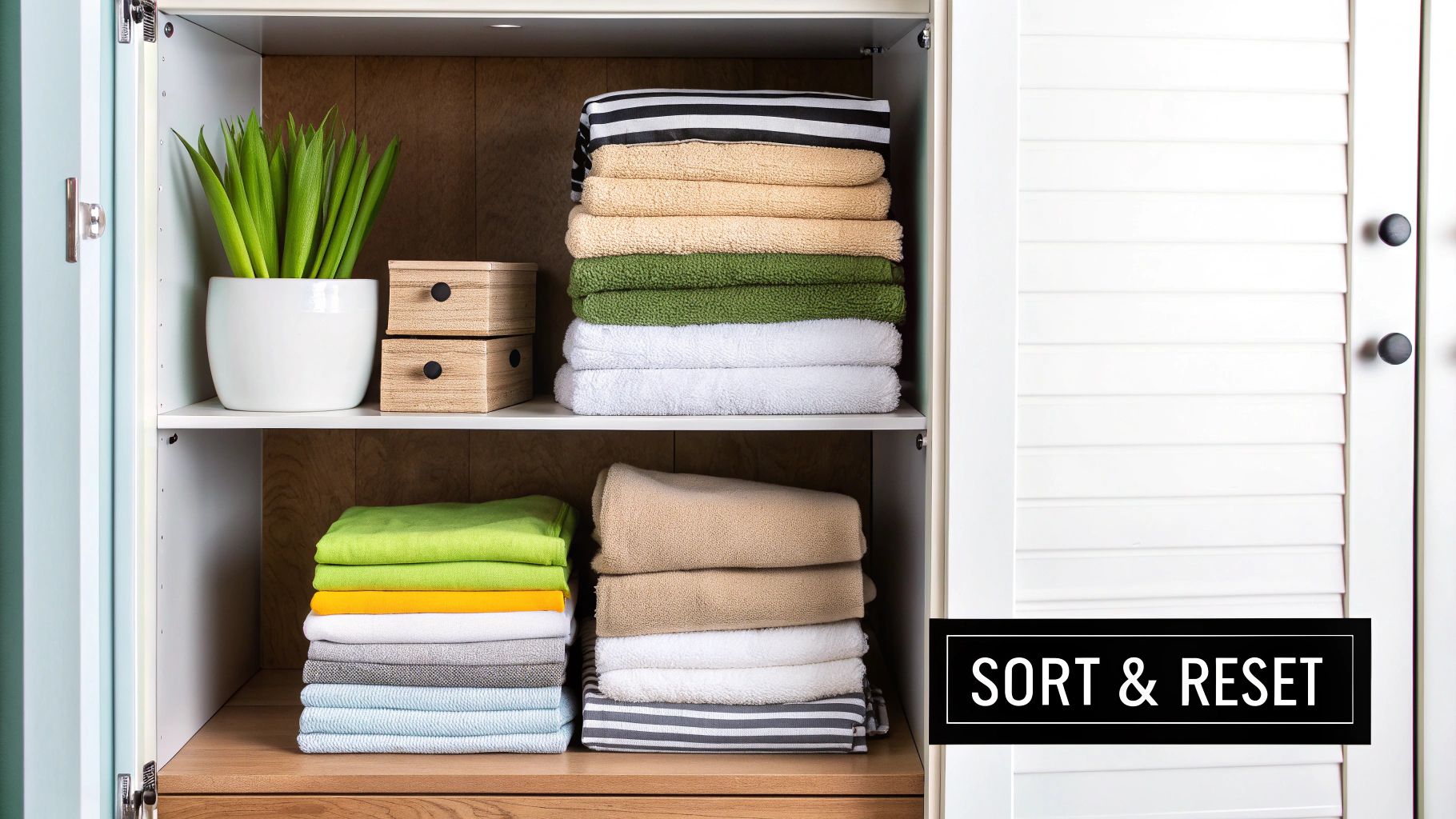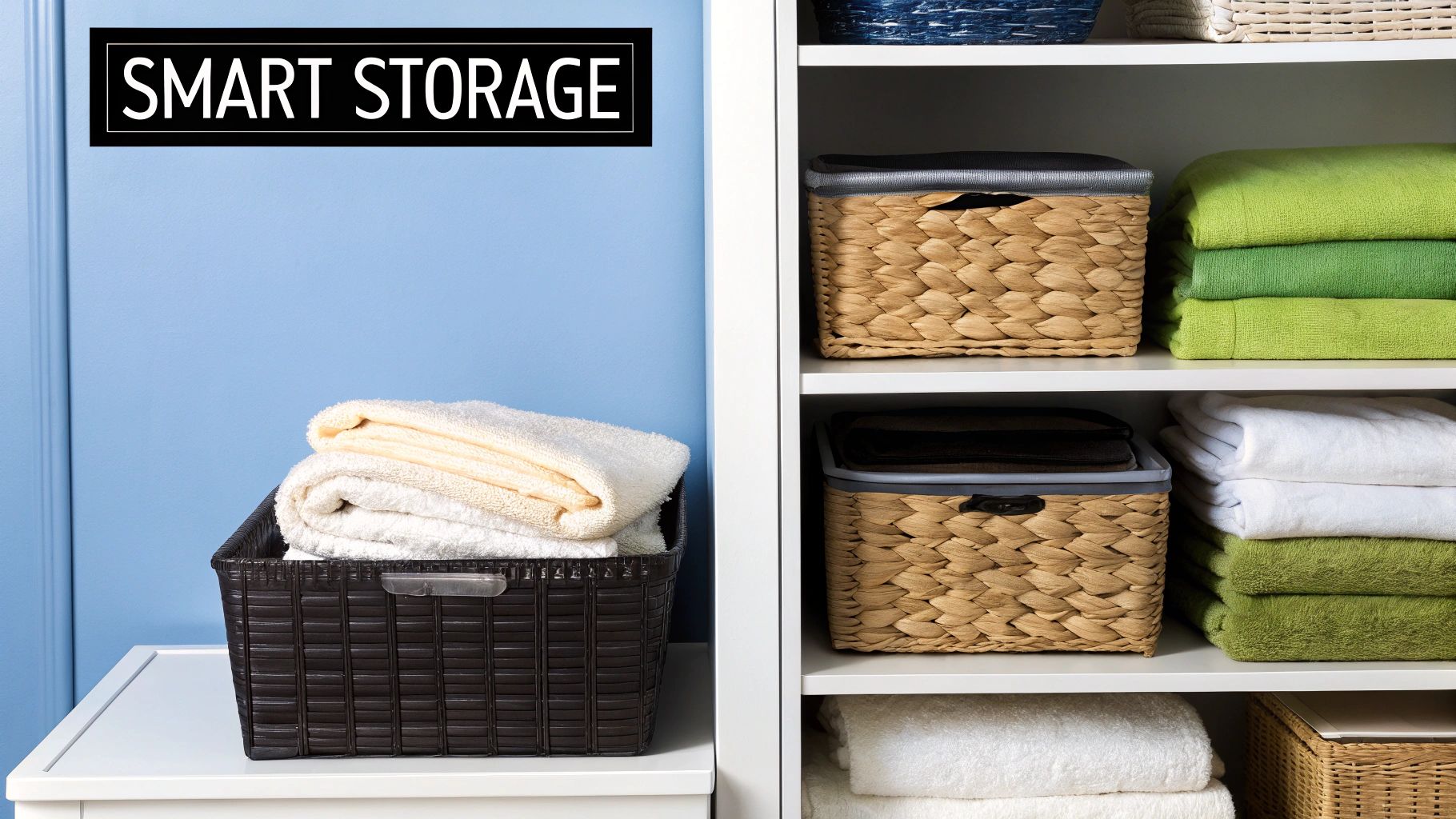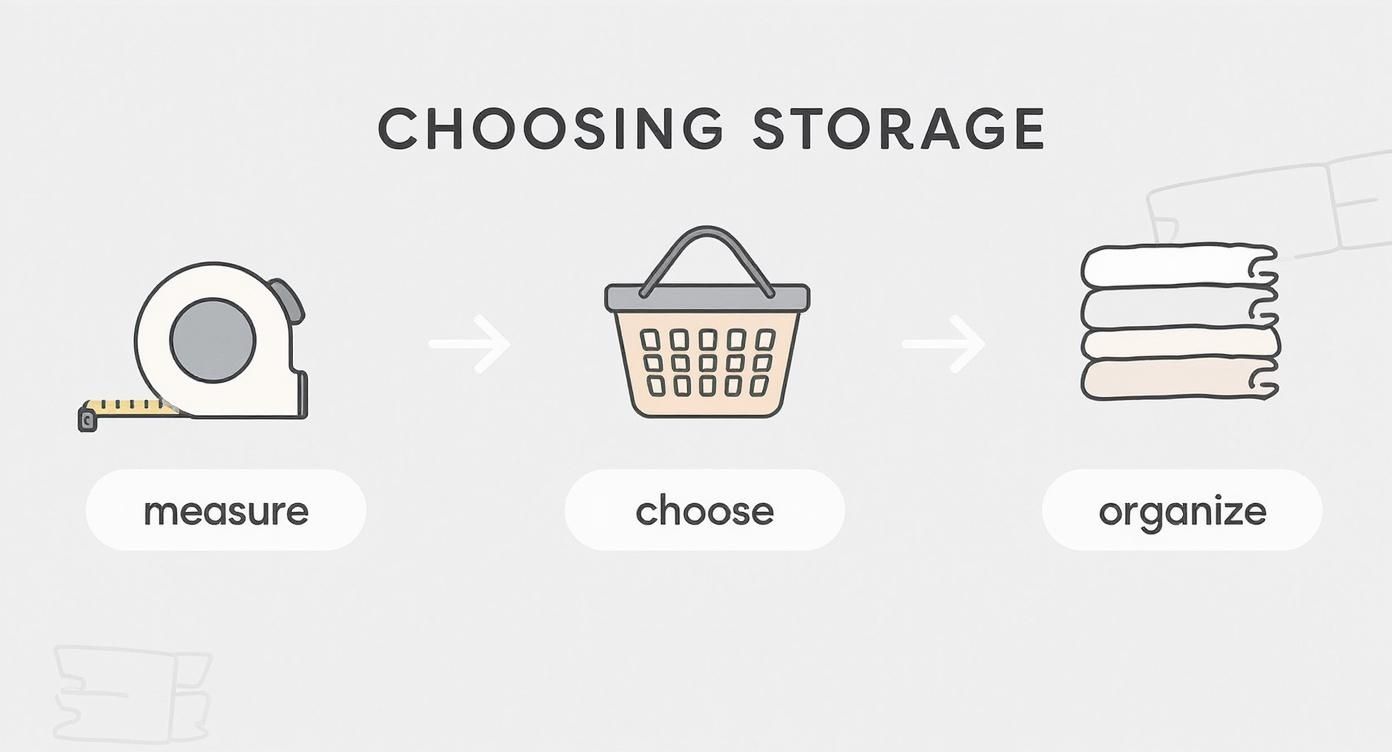Before you even think about clever folding techniques or stylish storage baskets, the real secret to a beautifully organised linen cupboard is a ruthless declutter. It all starts by emptying absolutely everything out and sorting it. This initial reset is the only way to build a system that actually works and, more importantly, lasts.
Your First Step to a Tidy Linen Cupboard

To get started, you need a completely blank canvas. Pull every single item out—yes, even that mystery blanket wedged in the very back corner. Lay it all out on a bed or the floor so you can see exactly what you're dealing with.
This isn’t just about tidying; it’s about making honest decisions about what deserves to take up precious space in your home. It’s a classic scenario in Aussie homes: the linen cupboard becomes a graveyard for threadbare towels, orphaned pillowcases, and sheet sets for a bed you no longer own.
Once it's empty, give the cupboard itself a good wipe-down. For a truly pristine space, you might even consider a professional deep cleaning service to get rid of any lingering dust and grime.
Creating Your Sorting Piles
Now for the hard part. It’s time to be honest with yourself as you sort every item into one of three piles.
This is where the three-pile system comes in handy. It’s a simple but effective framework for making quick decisions without getting overwhelmed.
The Three-Pile Sorting System
| Pile | Criteria for This Pile | Action to Take |
|---|---|---|
| Keep | Items in good condition, used regularly, and part of a complete set. | Put aside to be folded and returned to the cupboard. |
| Donate | Linens that are still usable but no longer needed. Guest towels you never use, old colours, or spare sets. | Bag up immediately and put in the car to drop at a charity bin. |
| Discard | Anything stained, frayed, ripped, or that’s lost its softness and absorbency. | Repurpose as cleaning rags or check local textile recycling options. |
This initial purge is easily the most impactful part of the whole process. It prevents you from just reorganising clutter.
Getting on top of household mess is proven to have a positive knock-on effect for your mental wellbeing. In fact, studies show that 40% of Australians feel anxious about the clutter in their homes.
Tackling the decluttering first ensures you are only storing items you genuinely use and love. It makes the entire system more efficient and so much easier to maintain down the track.
This mindset is central to good home organisation and ties directly into wider cleaning habits. If you're feeling motivated, our bedroom spring cleaning guide has more tips to help you refresh your personal spaces. Starting with a clean slate here sets you up for long-term success.
Creating a Linen System That Actually Works

Now that you’ve got a perfectly curated collection of linens, it’s time to build a system that actually makes sense for your home. This is where so many people go wrong. They just fold everything and put it back, only for it to become a jumbled mess within a week. The real secret is to create logical categories that stop the chaos before it starts.
There’s no single “right” way to do this, either. A system that works brilliantly for a family with young kids might be completely impractical for a couple. The goal is to figure out how your family naturally looks for things and build your system around that.
For some households, sorting by room is the most intuitive approach. All the master bedroom sheets and towels live on one shelf, while the kids' bathroom linens get their own dedicated spot. It makes it incredibly easy for everyone to find what they need without rummaging through stacks of unrelated items.
Grouping and Stacking Strategically
Another really effective method is to categorise by linen type. All bath towels live together, hand towels have their own pile, and sheet sets are grouped by size (queen, single, etc.). This system is especially useful in Australia, where bed linen makes up a huge 38.3% of the home textile market, largely driven by the popularity of queen-sized beds and bundled sets. If you want to know more, you can explore the latest Australian home textile trends. Storing these complete sets together becomes a key part of keeping your cupboard organised.
Once you’ve decided on your categories, think about shelf placement. Everyday items should be at eye level—no stretching or bending required.
- Daily-Use Towels: Pop these on the most accessible middle shelves.
- Spare Sheet Sets: These can also go on middle shelves for convenient weekly changes.
- Guest Linens: Store these on a higher shelf, as you won't be reaching for them as often.
- Seasonal Items: Bulky winter duvets or beach towels can be stored on the very top or bottom shelves, out of the way.
Pro Tip: The ultimate space-saving hack is to store each complete sheet set inside one of its matching pillowcases. Fold the fitted sheet, flat sheet, and the other pillowcase, then tuck the whole bundle inside the final pillowcase. You’ll never have to hunt for a matching piece again. It's a game-changer.
Choosing Storage That Fits Your Style and Space
Okay, you've sorted and folded your linens, so now for the fun part: choosing the containers that will pull it all together. This is where your linen cupboard goes from just being tidy to looking truly organised and stylish. The right storage is about function, of course, but it's also about finding something that feels good to look at every time you open the door.
Think about the look and feel you're going for. Woven baskets bring a lovely, natural texture and are perfect for hiding away mismatched towels or bulky blankets. On the other hand, clear plastic bins are incredibly practical. You can see exactly what’s inside at a glance, which is a lifesaver for guest bedding or finding the kids' single sheet sets in a hurry.
Wire baskets are another great option, especially for towels and quilts. They let the air flow freely, which is a simple but really effective trick to stop things from smelling musty over time. Keeping your linens fresh is half the battle, and it's something we talk about more in our guide on how to store your bedding properly.
Measure Twice, Buy Once
Before you even think about hitting the shops, grab a tape measure. This is non-negotiable. You need to know the exact depth, width, and height of your shelves. Trust me, there’s nothing more frustrating than bringing home a set of beautiful baskets only to discover they hang over the edge by a single centimetre.
The closet organiser market is huge, valued at around US$4.2 billion globally, so there are plenty of options out there. In Australia, wood materials are still a popular choice for their durability and classic look that suits most homes.
You don't need to spend a fortune on custom solutions. A set of matching, well-measured containers from a budget-friendly store can give you that same cohesive, streamlined look as a high-end system.
If your linen cupboard is on the smaller side, using clever small space storage ideas is key. It’s all about making every inch count and keeping that clutter from creeping back in.
Mastering Folding Techniques to Maximise Shelf Space
How you fold your linens isn't just a quirk for neat freaks; it's one of the smartest ways to reclaim precious shelf space. Bulky, uneven piles don't just look messy—they eat up a surprising amount of room. Getting a few simple, uniform folding methods down pat can completely change how much your cupboard can hold and how well it works.
Forget about just stacking things flat. For towels, the 'file folding' method is a total game-changer. Instead of laying towels on top of each other, you fold them into neat little rectangles that can stand upright, just like files in a filing cabinet. This lets you see every single towel at a glance and pull one out without the whole stack coming down.
Conquering the Fitted Sheet
Of course, the one item that causes the most grief is the fitted sheet. Those elasticated corners seem specifically designed to resist a tidy fold, usually ending up in a crumpled ball shoved to the back of the shelf.
But trust me, turning that shapeless sheet into a crisp, flat rectangle is easier than you think. The trick is to methodically tuck the corners into each other, creating a neat square that you can then fold down to whatever size you need. Nailing this skill is a true milestone in home organisation. For a simple walkthrough, check out our step-by-step guide on how to fold a fitted sheet.
By mastering just two or three consistent folding techniques, you can dramatically increase your storage capacity. It's not about being perfect; it's about creating a repeatable system that brings a little order and calm every time you open the cupboard door.
Now that your linens are beautifully folded, the visual guide below breaks down how to pick the right storage to complement them.

This simple flow—measure, choose, and organise—ensures that whatever storage solutions you pick will be a perfect fit for both your space and your neatly folded items.
Simple Habits to Keep Your Linen Cupboard Organised
Getting your linen cupboard perfectly organised is a great feeling, but the real secret is keeping it that way. Lasting success isn't about one big clean-out; it's about the small, consistent habits that stop the chaos from creeping back in.
A brilliant rule to live by is the 'one in, one out' principle. Every time you buy a new towel or sheet set, an old one has to go. This simple habit single-handedly prevents that slow, creeping clutter that happens when new things pile up. It forces you to be mindful about what you really need and use.
The Five-Minute Reset
Another little routine that works wonders is the five-minute monthly reset. Once a month, just take five minutes to open the cupboard and give it a quick tidy-up. Refold anything that’s been shoved in carelessly and make sure everything is back in its designated spot. It’s a tiny investment of time that stops small messes from turning into a weekend project.
To keep everything smelling lovely and deter moths, a few natural fresheners go a long way.
- Lavender Sachets: Tuck these between stacks of sheets for a calming, clean scent.
- Cedar Blocks: Place these on shelves to naturally repel pests and absorb any dampness.
Maintaining an organised space isn't about perfection. It's about creating a simple, sustainable system that actually works for your household. These little routines turn a one-time declutter into a lasting solution that genuinely makes life easier.
This philosophy of mindful maintenance also connects to the lifespan of your linens. Knowing how often to wash and replace bedding is a key part of this cycle, helping you keep your collection fresh and perfectly curated without any unnecessary excess. A tidy cupboard is really just a long-term commitment made easy with small, repeatable habits.
Your Questions About Linen Cupboard Organisation Answered
Even with a solid plan, a few tricky questions always pop up when you’re trying to get a linen cupboard sorted for good. From wrestling with bulky doonas to figuring out labels that actually stick, let’s tackle some of the most common hurdles you might run into.
Getting these details right is what makes your new system last. It’s the difference between a cupboard that looks good for a week and one that stays functional for years.
How Should I Store Bulky Items Like Doonas and Extra Pillows?
There's nothing quite like a big, fluffy doona to undo all your hard work. They can swallow an entire shelf in one go. The trick is to compress and contain them smartly.
For those seasonal items you won't touch for months, vacuum-sealed bags are your best friend. They’re brilliant—you can shrink a bulky winter doona by up to 75%, making it easy to stash on a top shelf or even slide under a bed. For extra pillows you might need for guests, large, structured fabric bins are perfect for keeping them contained and dust-free.
One thing you absolutely can’t skip: make sure any bulky bedding is completely clean and dry before you store it away. A slightly damp doona is a recipe for mould and mildew, so it's worth taking the extra time. Our guide on how to wash a doona walks you through the simplest way to get it done.
What Is the Best Way to Label Everything?
Labels aren't just for show; they make the whole system intuitive, so everyone in the house knows where things live. The best kind of label really just depends on the baskets or bins you’ve decided to use.
Here are a few options that work well:
- For Woven Baskets: You can’t go wrong with chic tie-on tags. Cardstock or thin wooden ones look great and are easy to change if you switch things around.
- For Opaque Bins: A simple adhesive label from a label maker is your best bet for a clean, uniform look that’s easy to read at a glance.
- For Wire Baskets: Clip-on metal labels are a fantastic choice. They’re durable, stylish, and they won’t fall off every time you pull the basket out.
Even if you’ve opted for clear bins, adding a label helps everyone know exactly what goes where. That’s half the battle won when it comes to keeping things tidy long-term.
How Often Should I Reorganise My Linen Cupboard?
A big overhaul like this should only be needed about once a year. The real secret to keeping your linen cupboard from descending back into chaos is doing small, regular bits of maintenance.
Try to set aside 10 minutes each season for a quick tidy-up. This is your chance to refold any messy stacks, pull out any towels or sheets that are looking a bit tired, and just make sure everything is back in its proper home. It’s this small, consistent effort that stops a beautifully organised space from becoming a jumbled mess all over again.
At Manchester Factory, we believe an organised home starts with beautiful, quality linens you love to use. Explore our collections of sheet sets, towels, and bedding to find the perfect pieces for your refreshed and functional space. Shop now.

